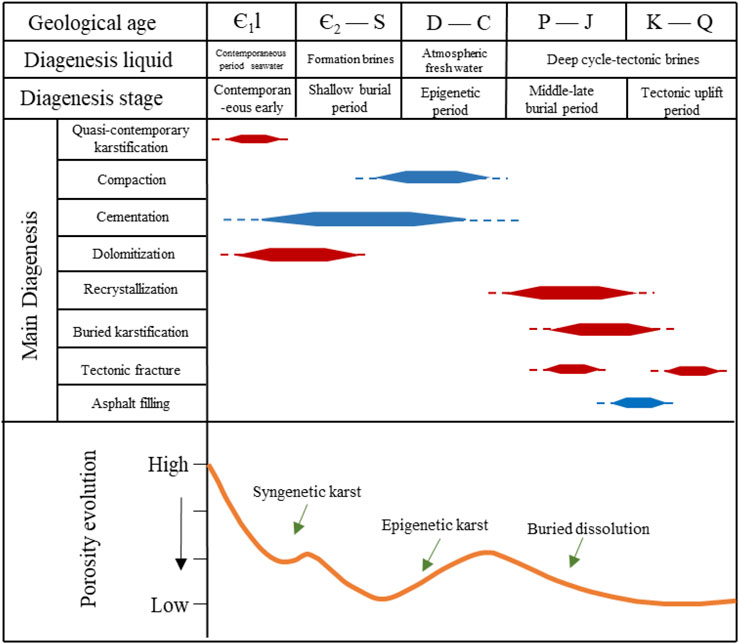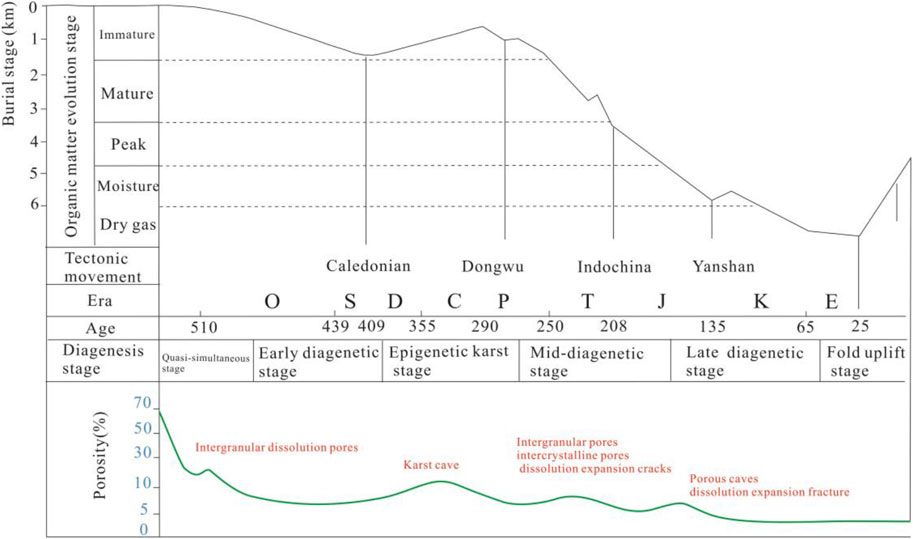- 1School of Geoscience and Technology, Southwest Petroleum University, Sichuan, China
- 2Geologic Exploration and Development Research Institute of Chuanqing Drilling Engineering Co., Ltd., CNPC, Chengdu, China
Based on the 4 measured profiles, 17 observation profiles, and 13 drilling core macroscopic and microscopic characteristics of the Cambrian Longwangmiao Formation in the Sichuan Basin, combined with analysis and testing, and reservoir logging interpretation, the reservoir characteristics and main controlling factors of the Longwangmiao Formation are analyzed. The marginal bank of the underwater paleo-uplift of the restricted platform and the point bank facies within the platform belong to the sedimentary facies belts that are most conducive to the formation and evolution of the reservoir. However, the later transformation of dolomitization and dissolution played decisive roles in the formation of the reservoir. The Caledonian epigenetic karstification is the main reason for the lack of the overlying stratum of the Cambrian in the Sichuan Basin, and it is also the most important factor for the formation of large-scale dissolved cavities in the Longwangmiao Formation in the Sichuan Basin.
1 Introduction
Carbonate reservoirs are mainly controlled by sedimentation, diagenesis and tectonic processes, so they have certain complexity, such as strong reservoir heterogeneity, complex pore evolution process, multi-stage tectonic movement and multi-stage oil and gas formation. Therefore, it is difficult to grasp the development and distribution rules of carbonate reservoirs. The predecessors have done a lot of work on the carbonate rocks of the Lower Cambrian Longwangmiao Formation in the Sichuan Basin. The research results show that the high-quality carbonate reservoirs of the Longwangmiao Formation are dominated by grain bank deposits, with well-developed dissolution pores and reservoirs (Zhang et al., 2020a; Zhang et al., 2021). The heterogeneity is strong, the formation and preservation mechanism of high-quality reservoirs is complex, and the vertical and horizontal distribution of reservoirs varies greatly (Yang et al., 2020a). Although some progress has been made in the research on the Cambrian Longwangmiao Formation in the early stage, there is a lack of systematic and in-depth research on the characteristics and main controlling factors of high-quality Longwangmiao Formation reservoirs, especially the high-quality deep carbonate reservoirs. The mechanism of formation and preservation is not well understood. Therefore, it is necessary to study the reservoir characteristics and main controlling factors of the Longwangmiao Formation comprehensively and systematically.
This paper intends to conduct a system of sedimentation, reservoir and accumulation conditions of the Lower Cambrian Longwangmiao Formation in Sichuan and surrounding areas. Combined with the existing exploration and research results, the reservoir characteristics are analyzed, and favorable reservoir development and distribution rules are confirmed. It is expected that the results can provide important geological basis for the later oil and gas exploration of the Longwangmiao Formation.
2 Geological Setting
The study area of this paper is the Sichuan Basin and surrounding areas, and its geographic scope covers most of Sichuan Province, Chongqing City and southern Shaanxi, western Hubei, northern Guizhou, and northeastern Yunnan Province (Figure 1). Existing exploration and research have shown that the dark mud shale of the Lower Cambrian Qiongzhusi Formation in the Sichuan Basin has huge thickness, high organic carbon content in the middle and lower parts, and has excellent hydrocarbon generation potential (Liu and Luo, 1991). The Middle-Upper Cambrian has deposited thick layers of carbonate rocks, among which the Longwangmiao Formation reservoirs in some areas are extremely developed and of high quality (Liu et al., 2020a; Gao et al., 2021; Shen et al., 2021). The Douposi Formation overlying the Longwangmiao Formation is mainly composed of fine-grained clastic rocks and tight carbonate rocks. The Ordovician Tongzi Formation and the Honghuayuan Formation overlying the Xixiangchi Group is a set of stable and tight carbonate (Liu et al., 2020a; Yang et al., 2020b). The Longwangmiao Formation (ϵ1l) is a set of typical carbonate deposits. The lithology is mainly crystalline dolomite and granular dolomite (Tang et al., 2019; Yang et al., 2021a; Yang et al., 2021b; Gao et al., 2021).

FIGURE 1. Plane distribution of sedimentary facies of the Lower Cambrian Longwangmiao Formation in the Sichuan Basin.
It is generally believed that during the Cambrian period, the Sichuan Basin and surrounding areas had a tendency to gradually deepen water from west to east and from north to south (Liu et al., 2020a; Chen et al., 2020). During the Longwangmiao deposition period, the Sichuan Basin was mainly composed of a carbonate platform environment, partially mixed tidal flat environment, a limited platform, open platform, platform margin, and slope-basin environment. Overall, it has a shallow depositional pattern in the west, deep in the northeast and southeast (Zhang et al., 2019a; Liu et al., 2020a; Gao et al., 2021) (Figure 1).
3 Petrological Characteristics of Longwangmiao Formation
Studies have shown that the Cambrian Longwangmiao Formation in the Sichuan Basin is mainly composed of dolomite, limestone and gypsum salt rock. Its reservoirs are mainly distributed in dolomite, with less limestone. Different rock types will also cause large differences in reservoir performance (Table 1).
3.1 Dolomite
The reservoirs of the Cambrian Longwangmiao Formation in the Sichuan Basin belong to dolomites, which mainly include two types of granular dolomite and crystalline dolomite.
3.1.1 Granular Dolomite
Common particle types in granular dolomite include sand-clastic, oolites, gravel, bean, bioclastic, and a small amount of algal sand clastic (Figures 2A–D). The granular dolomite in the central Sichuan area develops splendid crystals, often in the 2 to 3 stages of powder-fine-crystalline dolomite, medium-crystalline dolomite and other cements distributed among the grains. And the intergranular filling is dominated by dolomitic mud.
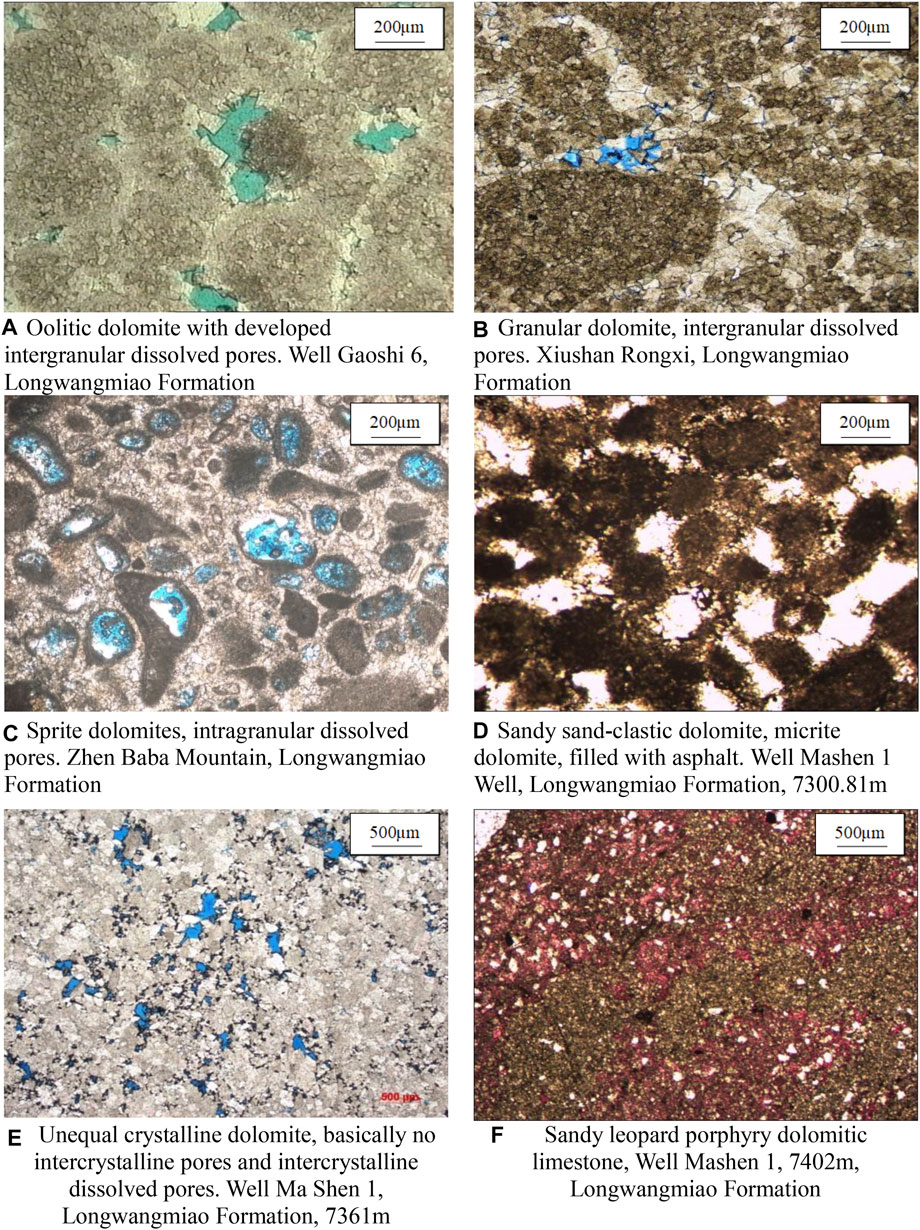
FIGURE 2. The petrological characteristics of Cambrian dolomite in Sichuan Basin. (A). Oolitic dolomite with developed intergranular dissolved pores. Well Gaoshi 6, Longwangmiao Formation, (B). Granular dolomite, intergranular dissolved pores. Xiushan Rongxi, Longwangmiao Formation, (C). Sprite dolomites, intragranular dissolved pores. Zhen Baba Mountain, Longwangmiao Formation, (D). Sandy sand-clastic dolomite, micrite dolomite, filled with asphalt. Well Mashen 1 Well, Longwangmiao Formation, 7,300.81 m, (E). Unequal crystalline dolomite, basically no intercrystalline pores and intercrystalline dissolved pores. Well Ma Shen 1, Longwangmiao Formation, 7,361 m, (F). Sandy leopard porphyry dolomitic limestone, Well Mashen 1, 7,402 m, Longwangmiao Formation.
3.1.2 Crystalline Dolomite
According to the size of the crystal grains, it can be further divided into mud-powder crystal dolomite, powder-fine crystal dolomite, medium crystal dolomite and unequal crystal dolomite. The best reservoir performance is mainly powder crystal, fine crystal and mesocrystalline dolomite. The crystal form is mainly semi-automorphic-automorphic (Figure 2E). Part of the grain dolomite can see the phantom structure of the particles under the microscope. Based on this, it is inferred that the part of crystalline dolomite is the product of grain banks, but its structure has changed during the process of intense dolomitization and recrystallization.
3.1.3 Sandy Granular Dolomite
The grains in the sandy grain-bearing dolomite are mainly sand debris, and the content can reach 50–65%. In addition, it also contains a certain amount of terrigenous quartz sand and silt sand with a content of 10–20% (Figure 2D). This type of rock is mainly distributed in the northern Sichuan region.
3.2 Limestone
The main storage performance of limestone reservoirs is significantly worse than that of dolomite reservoirs. The matrix porosity is small, and it is located in granular dolomitic limestone and micrite limestone.
3.2.1 Granular Dolomitic Limestone
The dolomite content is 0–35%, and the coarser self-shaped dolomite preferentially replaces the particles and part of the stucco matrix (Figure 2F). The particle content is 50–70%, mostly in the form of basal cementation, and selective dissolution occurs in the local or between the particles, forming a small amount of intragranular and intergranular dissolved pores. The surface area ratio is generally less than 2%, and the storage performance is poor.
3.2.2 Crystalline Limestone
Granular limestone is mainly developed in the Longwangmiao Formation in the east and southeast of the Sichuan Basin. Mud-silt crystalline limestone is the most common one, and there is almost no storage space. When fractures are developed, fractured reservoirs can be formed.
4 Diagenesis of Longwangmiao Formation
In particular, the main types and characteristics of the diagenesis of Longwangmiao formation in the Sichuan Basin have been studied in more detail (Table 2).

TABLE 2. Summary of the main diagenetic environment of Cambrian reservoirs in the Sichuan Basin—diagenesis—diagenesis effects.
4.1 Destructive Diagenesis
The destructive diagenesis in the reservoir mainly includes compaction and cementation, which can destroy the early sedimentary fabric and early pores. The reservoirs of the Longwangmiao Formation in the Sichuan Basin are all the products of these destructive diagenesis.
4.1.1 Compaction
In the particle-supported carbonate rock, the oolites and bioclastic particles are often deformed and arranged in elongated qualitatively, leading to the rupture, fragmentation and plastic deformation of various oolites. At the same time, the particle plane or curved surface contact caused by plastic deformation is also common (Figure 3A). Pressure solution usually occurs in a deeper burial diagenesis stage, and the pressure solution fractures and sutures formed at the contact positions of two different lithologies often cut oolites and buried cement (Figure 3B).
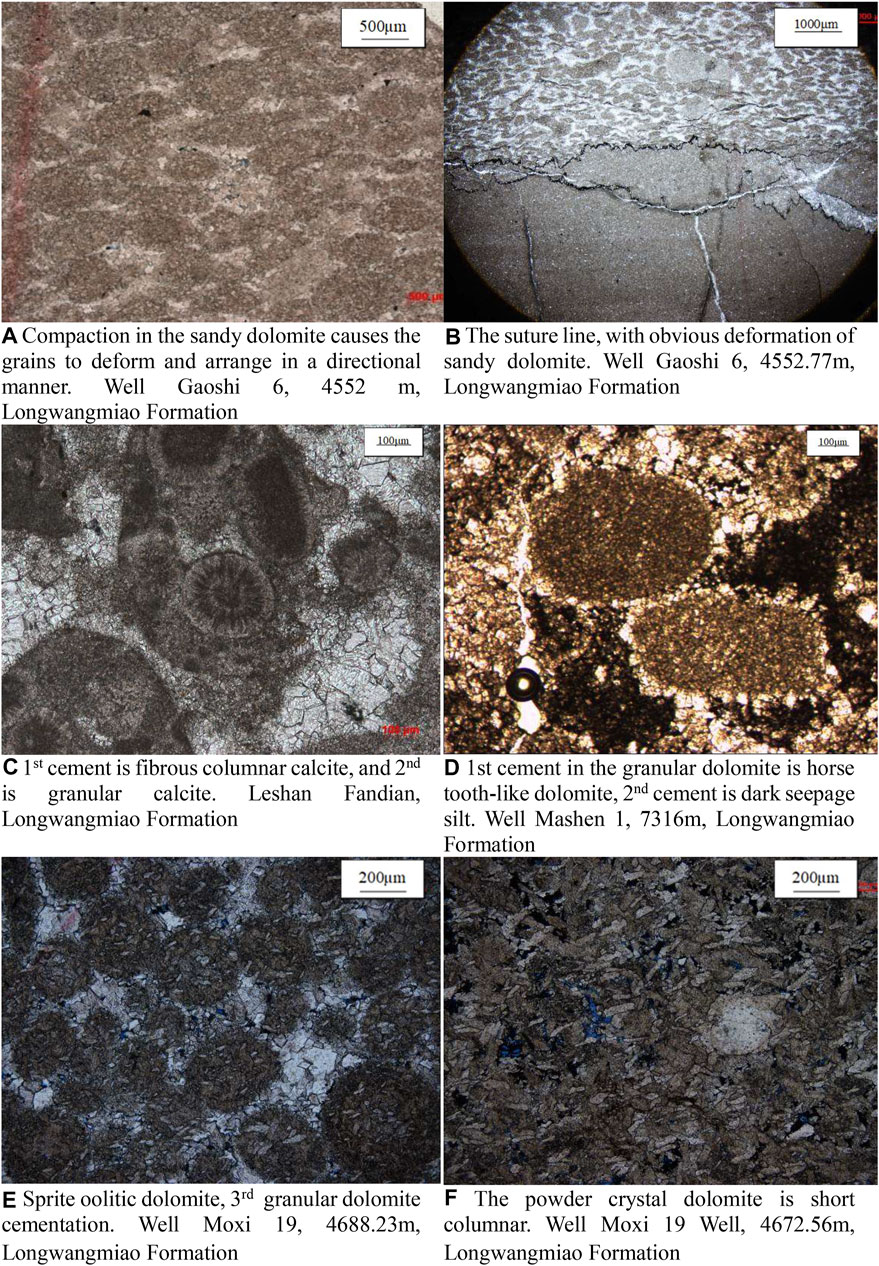
FIGURE 3. Destructive diagenesis characteristics of the Longwangmiao Formation reservoir in the Sichuan Basin. (A). Compaction in the sandy dolomite causes the grains to deform and arrange in a directional manner. Well Gaoshi 6, 4552 m, Longwangmiao Formation, (B). the Suture line, with Obvious deformation of Sandy dolomite. Well gaoshi 6, 4,552.77 m, longwangmiao formation, (C). 1st cement is fibrous columnar calcite, and 2nd is granular calcite. Leshan Fandian, Longwangmiao Formation, (D). 1st cement in the granular dolomite is horse tooth-like dolomite, 2nd cement is dark seepage silt. Well Mashen 1, 7,316 m, Longwangmiao Formation, (E). Sprite oolitic dolomite, 3rd granular dolomite cementation. Well Moxi 19, 4,688.23 m, Longwangmiao Formation, (F). The powder crystal dolomite is short columnar. Well Moxi 19 Well, 4,672.56 m, Longwangmiao Formation.
4.1.2 Cementation
Cementation is one of the most important factors to destroy the pores and reduce the porosity of the granular dolomite and granular limestone reservoirs. Cementation is very developed in the granular rocks deposited in the bank facies, mainly formed in primary pores, dissolution cavities and cracks. The cementation products mainly include dolomite, calcite, quartz, pyrite and asphalt, etc. Dolomite is the most important cement in the granular dolomite of Longwangmiao Formation. The dolomite cemented filler can roughly identify the following four stages:
4.1.2.1 The First Phase of Seabed Cementation
The first-stage cements were generally aragonite and high-magnesium calcite minerals at the beginning of the deposition, which were transformed into dolomite through dolomitization and recrystallization (Figure 3C). The cements of this period are usually formed in the seawater undercurrent environment, and mostly appear in oolitic dolomite, bean dolomite, sandy dolomite and bioclastic dolomite of high-energy bank facies.
4.1.2.2 The Second Phase of Congenital-Quasi Congenital Atmospheric Water Cementation
In the process of sea level rise and fall in the sedimentary stage, the landform highland inside the platform will be frequently exposed to the sea level and will be modified by the atmospheric fresh water. The atmospheric sedimentary rock environment includes the seepage zone and the underflow zone. The interstitials formed in the seepage zone are mainly crescent or overhanging cements, and seepage silt composed of micrite calcite or dolomite (Figure 3D). And then become dolomite after dolomitization.
4.1.2.3 The Third Phase of Shallow-Buried Granular Dolomite Cementation
In this period, the shallow buried granular dolomite cement is filled in the center of the intergranular pores in the form of other-shaped single crystals or embedded crystals (Figure 3E).
4.1.2.4 Paste Cementation
In addition to the above-mentioned dolomite and calcite cementation types, a type of cementation related to gypsum can also be seen in the granular dolomites of the Longwangmiao Formation reservoirs in the southwest and north of the Sichuan Basin. Part of the granular dolomite, slab-like and columnar gypsum cemented granular rocks were replaced by dolomite in the later stage, forming gypsum pseudocrystals (Figure 3F).
4.2 Constructive Diagenesis
Most of the storage space in the current reservoirs of the Longwangmiao Formation in the Sichuan Basin is the product of multiple periods of constructive diagenesis. These constructive diagenesis mainly include recrystallization, dolomitization and multi-phase dissolution.
4.2.1 Recrystallization
With the increase of burial depth and temperature, the recrystallization of carbonate rocks gradually strengthened, which is mainly manifested by the increase of crystal grains and the tendency to self-shape. Generally speaking, dolomites with uneven distribution of insoluble residues often form unequal crystal dolomites after being recrystallized (Figure 4A). Recrystallization makes the throats between the intercrystalline pores smoother and straighter, thereby increasing the effective porosity and permeability of the rock.
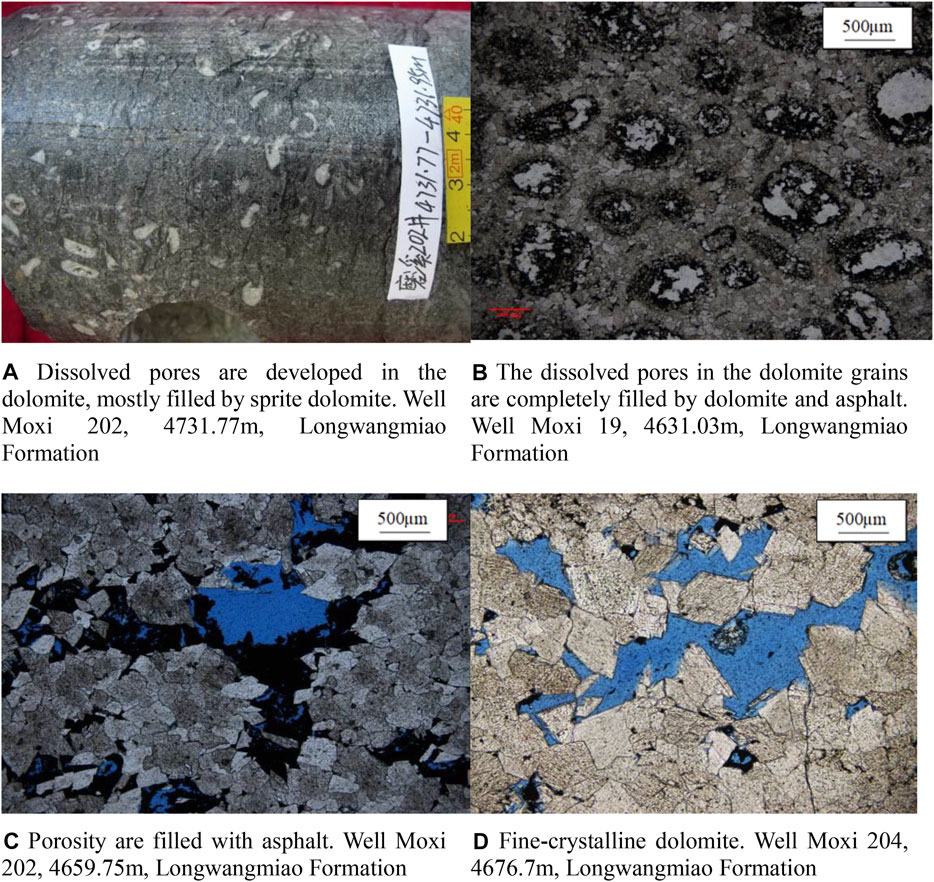
FIGURE 4. Dissolution characteristics of Longwangmiao Formation in Sichuan Basin. (A). Dissolved pores are developed in the dolomite, mostly filled by sprite dolomite. Well Moxi 202, 4,731.77 m, Longwangmiao Formation, (B). The dissolved pores in the dolomite grains are completely filled by dolomite and asphalt. Well Moxi 19, 4,631.03 m, Longwangmiao Formation, (C). Porosity are filled with asphalt. Well Moxi 202, 4,659.75 m, Longwangmiao Formation, (D). Fine-crystalline dolomite. Well Moxi 204, 4,676.7 m, Longwangmiao Formation.
4.2.2 Dolomitization
The analysis of the whole-rock carbon and oxygen isotope test results of the Longwangmiao Formation in the Sichuan Basin (Table 3) shows that the sandy dolomite bedrock did not have significant negative shifts, indicating the fluid source is relatively sufficient.
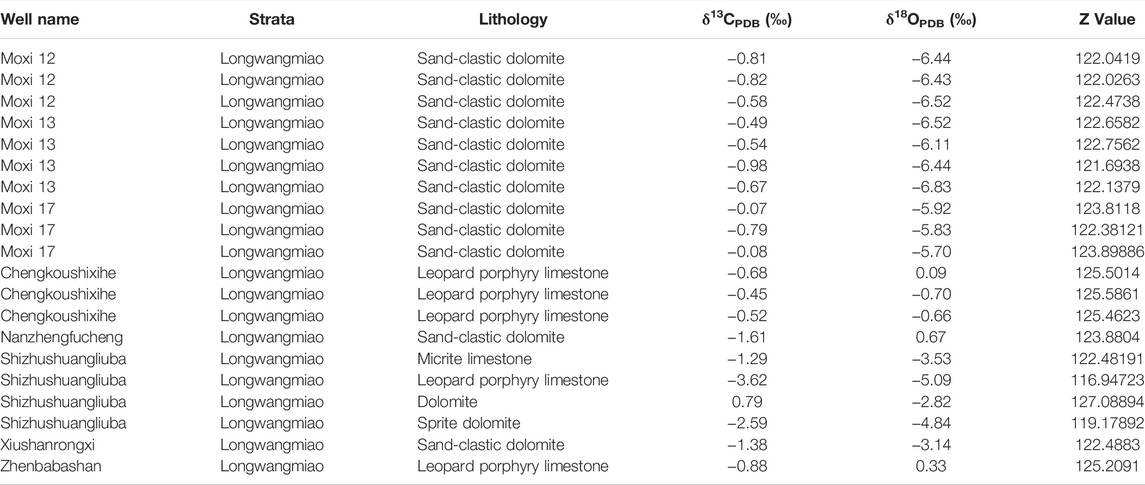
TABLE 3. Dolomite carbon and oxygen isotope distribution table and calculated Z value of Longwangmiao Formation in Sichuan Basin.
According to the empirical formula: Z = a (δ13C + 50) + b (δ18O + 50) (a = 2.048,b = 0.489). The Z value of all test samples is greater than 120, indicating that the cause is marine origin. Therefore, its dolomite is not significantly modified by atmospheric fresh water during the same period. The dolomite origin is an early metasomatic origin closely related to the evaporation and concentration of high-salinity seawater and backflow infiltration.
4.2.3 Karstification
According to the time and product characteristics of karstification, the dissolution of Longwangmiao Formation can be divided into three types: syngenetic-quasi-contemporaneous karst, epigenetic karst and buried karst. These karsts have been superimposed and formed in the long-term geological history.
4.2.3.1 Syngenetic-Quasi-Contemporaneous Karstification
Atmospheric freshwater dissolution during the syngenetic period mainly occurs in the shallower tidal flats and in-platform bank sediments with higher sedimentary landforms, especially in the grain banks with strong energy deposited on the high landforms. The Cambrian strata with these pores experienced long-term burial, and most of the intragranular dissolved pores and mold cavities formed in the early stage were filled by the late dolomite (Figures 4A,B).
4.2.3.2 Burial Karstification
There are two main phases of dissolution during the burial period. The first phase occurred before and during the large-scale maturation of organic matter. The ground layer was buried to 2,000–3,000 m, the ancient geothermal temperature was 80–120°C, and the Ro value was 0.16–1.0%. The organic matter in the thick dark mud shale of the Lower Cambrian Qiongzhusi Formation and the Lower Cambrian Qiongzhusi Formation has entered the mature period, and the released formation water containing a large amount of organic acids, CO2 and other corrosive components (Zhang et al., 2020b). The second stage of burial dissolution occurred in the late mid-diagenesis burial stage-oil evolved into bitumen. When the corrosive components such as organic acids, CO2, H2S and CH4 formed by the cracking of liquid hydrocarbons migrate along the above-mentioned weak spots (Zhang et al., 2020c), they will further dissolve the crystalline dolomite reservoirs (Figures 4C,D).
4.3 Diagenetic Sequence
Through the analysis of various diagenesis characteristics of the Longwangmiao Formation reservoir in the Sichuan Basin above, it can be seen that the reservoirs mainly have submarine cementation, mechanical compaction in the shallow burial period, dolomitization, recrystallization, multi-stage karst and various fillings. These different types of diagenesis occur in different diagenetic environments and also in different diagenetic periods (Figure 5).
5 Reservoir Characteristics of Longwangmiao Formation
In accordance with the statistical analysis of core physical data, this project conducted a research on the storage space and physical properties of the reservoir in the main reservoir sections of the Cambrian in the Sichuan Basin.
5.1 Reservoir Space Type
Based on detailed observation of Cambrian field profiles, cores observation, thin sections, and scanning electron microscopy in the Sichuan Basin, according to their genesis, morphology, size and distribution location, this article will focus on the storage space divided into three categories and more than ten kinds of the Cambrian Longwangmiao Formation in the Sichuan Basin (Table 4).

TABLE 4. Reservoir space type and distribution frequency summary table of the Cambrian Longwangmiao Formation in the Sichuan Basin.
5.1.1 Porosity
5.1.1.1 Residual Intergranular Pores
Residual intergranular pores are distributed in sprite dolomite, sprite oolitic dolomite, and residual sacrificial silt dolomite (Figure 6A). The aperture is generally 0.015∼0.075 mm, the larger is 0.15 mm, the aperture ratio is mostly 1%–3%, and the local area can reach 8%. However, the residual intergranular pores in the bank facies reservoirs of the Cambrian Longwangmiao Formation mostly occurred in the later stage of dissolution and expanded to form intergranular dissolved pores and caves.
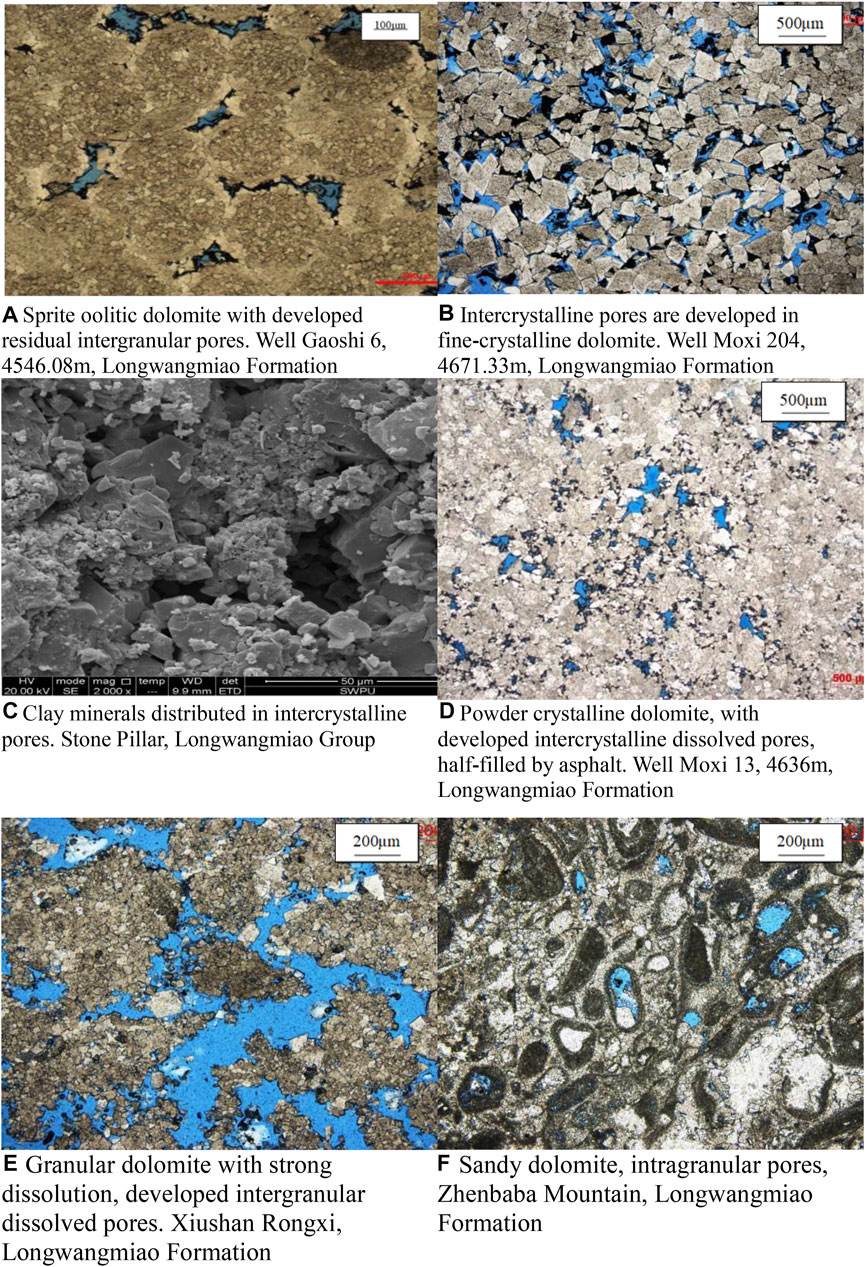
FIGURE 6. Characteristics of pores and hole in Cambrian reservoirs in the Sichuan Basin (I). (A). Sprite oolitic dolomite with developed residual intergranular pores. Well Gaoshi 6, 4,546.08 m, Longwangmiao Formation, (B). Intercrystalline pores are developed in fine-crystalline dolomite. Well Moxi 204, 4,671.33 m, Longwangmiao Formation, (C). Clay minerals distributed in intercrystalline pores. Stone Pillar, Longwangmiao Group, (D). Powder crystalline dolomite, with developed intercrystalline dissolved pores, half-filled by asphalt. Well Moxi 13, 4636 m, Longwangmiao Formation, (E). Granular dolomite with strong dissolution, developed intergranular dissolved pores. Xiushan Rongxi, Longwangmiao Formation, (F). Sandy dolomite, intragranular pores, Zhenbaba Mountain, Longwangmiao Formation.
5.1.1.2 Intercrystalline Pores
It mainly exists in crystalline dolomite and develops among dolomite crystals with a higher degree of self-shape. The pore size between silt dolomite crystals is generally <0.01 mm, and the pore size between fine-medium crystalline dolomite crystals is generally 0.02–0.04 mm (Figure 6B). The intercrystalline pores in some clay-bearing silt dolomites are also filled with clay minerals such as filamentous illite and page kaolinite (Figure 6C).
5.1.1.3 Intercrystalline Dissolution Pores
Intercrystalline dissolution pores are formed by dissolution on the basis of intercrystalline pores, and their formation is caused by the migration of acidic water along the intercrystalline pores, which makes the crystal morphology of eumorphic dolomite become irregular. The pore morphology is extremely irregular (Figure 6D), generally ranging from 0.03 to 0.1 mm in size. Intercrystalline pores are most developed in the grain dolomite of the Longwangmiao Formation.
5.1.1.4 Intergranular Dissolution Pores
Intergranular dissolution pores refer to the pores formed by strong dissolution of the dolomite cement in the splendid dolomite. The edges of the pores are harbour-like, and small intergranular dissolved pores can be seen with the dissolution residues of the bright crystal cement. When the dissolution is very strong, the pore size can be larger than the particles. At this time, there is almost no residue of splendid cement (Figure 6E).
5.1.1.5 Dissolved Pores in Grains and Casting Holes
Intragranular dissolved pores refer to the dissolved pores inside carbonate particles, which are mainly distributed in the grains of sand clastic dolomite and oolitic dolomite (Figure 6F). It is the dissolution of atmospheric fresh water during the same depositional period to form dissolution holes inside the carbonate particles. After that, it is fully filled and semi-filled by eutectic calcite, dolomite, quartz and asphalt. The filling can be eroded again at a later stage, so that the euhedral dolomite inside the particles is eroded into irregular shapes or fragments.
5.1.2 Cave
Voids with a diameter greater than 2 mm are called cavities. The formation of karst caves is the same as that of various dissolved pores, except that the size of the pores is different. The further expansion of the scale of various dissolved pores is the formation of karst caves (Figures 7A,B). The argillaceous micrite dolomite is formed by dissolution and transformation along cracks or gypsum-salt mold pores (Figures 7C,D), the diameter of the cave is > 2 mm. On the field profile, the current atmospheric freshwater leaching transformation has further expanded the caves originally developed in the granular dolomite, forming a dense layer of honeycomb-shaped caves closely related to the development of the granular bank cycle.
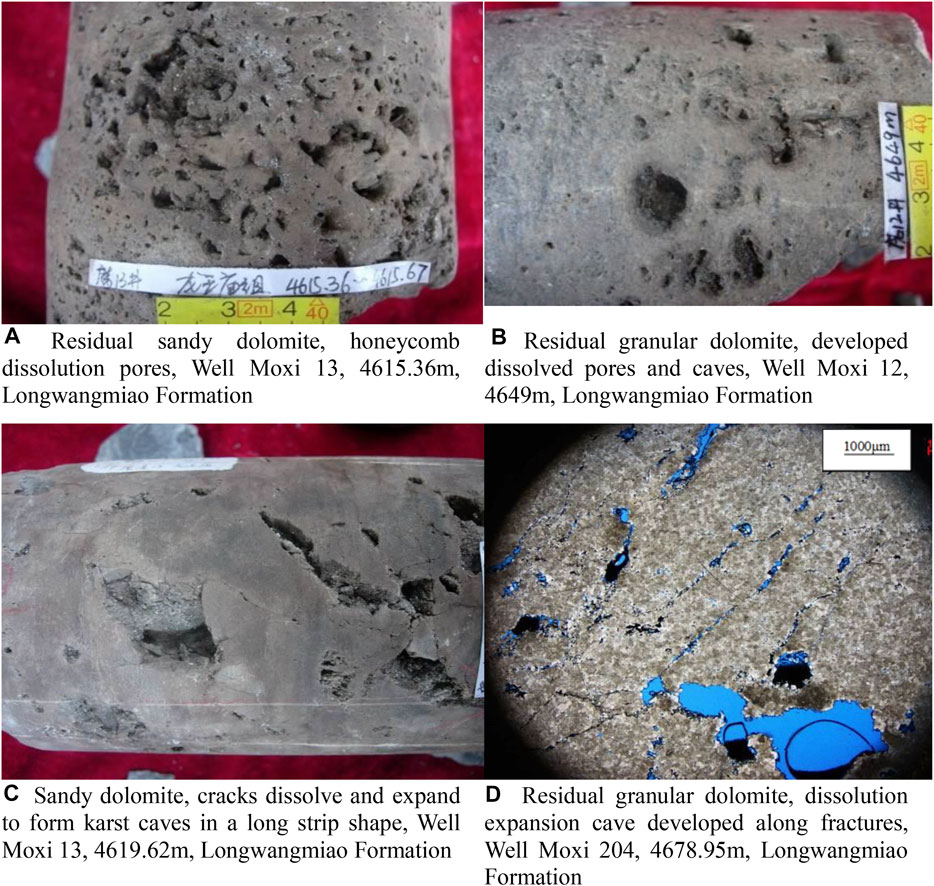
FIGURE 7. Characteristics of pores and hole in Cambrian reservoirs in the Sichuan Basin (II). (A). Residual sandy dolomite, honeycomb dissolution pores, Well Moxi 13, 4,615.36 m, Longwangmiao Formatio, (B). Residual granular dolomite, developed dissolved pores and caves, Well Moxi 12, 4,649 m, Longwangmiao Formation, (C). Sandy dolomite, cracks dissolve and expand to form karst caves in a long strip shape, Well Moxi 13, 4,619.62 m, Longwangmiao Formation, (D). Residual granular dolomite, dissolution expansion cave developed along fractures, Well Moxi 204, 4,678.95 m, Longwangmiao Formation.
5.1.3 Fracture
Based on core observation and comprehensive analysis of on-site gas test results, the development degree of fractures in the core section of the Longwangmiao Formation in central Sichuan was calculated (Figure 8). It is found that the Longwangmiao Formation has a large fracture development density, numerous formations, and large differences in characteristics (Wang et al., 2019). The structural fractures of the Longwangmiao Formation in central Sichuan are mostly high-angle fractures, and the length on the core varies from 0.2 to 1.5 m. Tracing back to the structural development history of the study area, it can be seen that since the Early Cambrian, the study area has been continuously reformed by various tectonic movements including Caledonian, Indosinian, Yanshanian and Himalayan movements.

FIGURE 8. Histogram of fracture development in the Lower Cambrian Longwangmiao Formation reservoir in central Sichuan.
5.2 Reservoir Physical Characteristics
According to the statistics of the pore number test of small samples of the Longwangmiao Formation, the porosity of the Longwangmiao Formation is 0–12%, with an average of 3.11%, and the frequency of occurrence of samples less than 2% is 52.16% (Figure 9A). According to statistics of the full-diameter pores of the Longwangmiao Formation, the porosity ranges from 0 to 12%, with an average of 5.32%, and the frequency of occurrence of samples less than 2% is 11.11% (Figure 9B). According to the statistics of the sample permeability data, the permeability of the Longwangmiao Formation is concentrated in the range of 0–100 md, with an average of 5.2 md, and 14.38% less than 0.001 md (Figure 9C). According to statistics of the full diameter permeability data, the permeability of the Longwangmiao Formation is concentrated in the range of 0–100 md, with an average of 30.4 md, and 1.23% less than 0.001 md (Figure 9D). It can be seen from the above data that the entire Longwangmiao Formation is a low-permeability reservoir with rarely high-permeability characteristics.
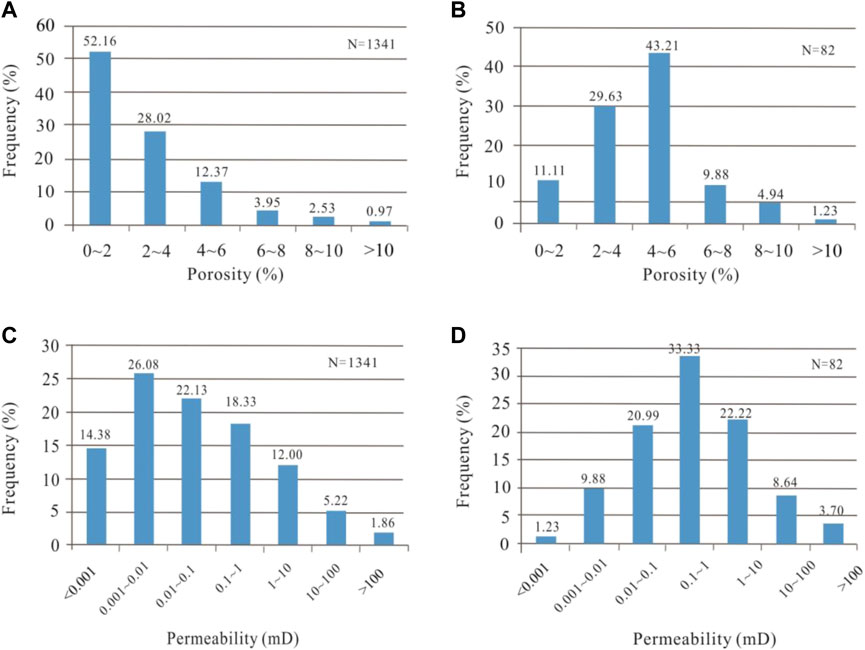
FIGURE 9. Histogram of porosity and permeability distribution of Longwangmiao Formation in central-southwestern Sichuan Basin.
6 Main Controlling Factors of the Reservoir
Generally speaking, the formation, evolution, development and distribution of carbonate reservoirs, as well as the quality of the reservoirs, are jointly controlled by sedimentation, diagenesis, and structural fracture. Sedimentation and its products are the basis of reservoir formation and evolution. Diagenesis and structural fracture are the keys to reservoir formation and reformation (Tang et al., 2019; Hu et al., 2020).
6.1 Sedimentary Facies Is the Basis of Reservoir Formation
Sedimentary facies is one of the main factors that control the development of Cambrian carbonate reservoirs in the Sichuan Basin. And the sedimentary differentiation within the carbonate platform is controlled by changes in paleogeographical patterns, landform fluctuations, and seawater caused by tectonic activities (Hu et al., 2020). Comparing the reservoir performance with different lithologies (Figure 10), it is found that granular dolomite has better storage and permeability performance, followed by crystalline dolomite. The granular dolomite here is mainly formed in the higher energy position in the underwater paleo-uplift bank, which is the best reservoir rock type of the Cambrian in the Sichuan Basin (Zhang et al., 2019b). The second is the point bank granular dolomite distributed near the wave base around the low-energy lagoon in the confined platform at that time; the crystalline dolomite in the confined platform, especially the pure crystalline dolomite, is often composed of powder-fine crystalline dolomite. It can develop a certain number of intercrystalline pores and intercrystalline dissolved pores. However, mud-silt dolomite and unequal dolomite are generally dense in lithology, with only a few intercrystalline pores, intercrystalline dissolved pores and gypsum mold pores in the storage space, and are often filled with asphalt and dolomite, with low porosity. In general, the storage performance of granular dolomite or low-energy powder-fine-grained dolomite deposited in water bodies with higher energy is far greater than that of micrite dolomite or unequal-crystalline dolomite deposited in low-energy environments (Huang et al., 2018). Early lithology differences provided the material basis for the formation of reservoirs (Xi et al., 2020).
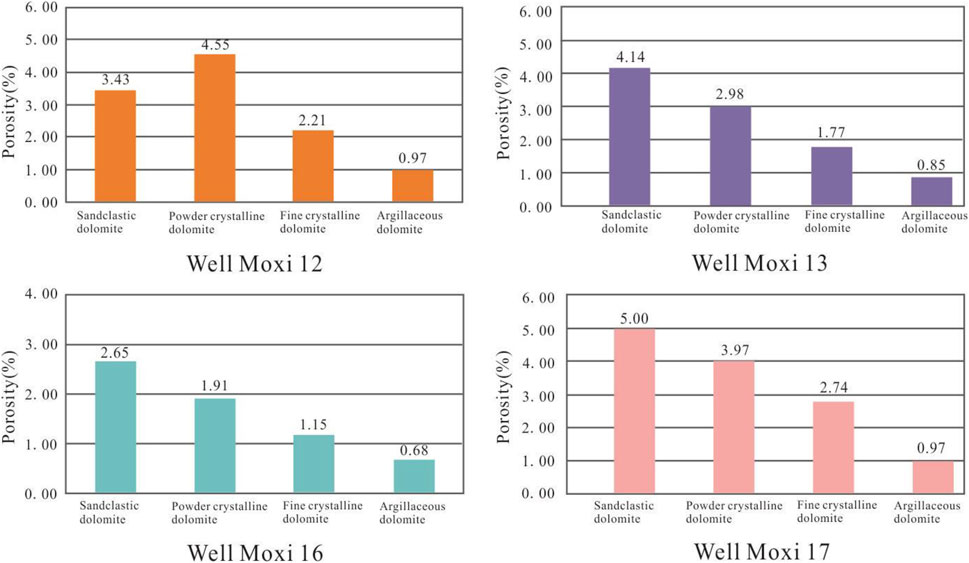
FIGURE 10. The histogram of the relationship between lithology and porosity of the Longwangmiao Formation in the Sichuan Basin.
6.2 Diagenesis is the Key to Reservoir Formation and Evolution
In general, the reservoir has experienced the syngeneic submarine diagenesis stage, the quasi-contemporaneous epigenetic rock stage, the shallow-medium-deep burial period diagenesis stage, and the uplift exposure diagenesis stage. The types of diagenesis include compaction, cementation, dissolution, dolomitization and metasomatism, etc.
6.2.1 Dissolution
Burial dissolution should be said to be the most direct controlling factor for the formation of effective reservoir space of Cambrian dolomite, and its development and transformation of reservoirs is also closely related to the existence of early pore layers. The burial dissolution in the Cambrian carbonate reservoirs in the Sichuan Basin has the following characteristics: 1) Dissolution mainly occurs between grains or crystals, forming intergranular or intercrystalline dissolved pores and caves, while intragranular dissolution does not develop. This is related to the late occurrence of burial dissolution, unstable mineral components have been transformed into stable minerals, and acidic groundwater is more likely to flow in pores. 2) the dissolution of structural fractures and formation of dissolution fractures. 3) late cements Dissolution: Dissolution of fine-medium crystalline dolomite fillings in pores and cracks.
In the Longwangmiao Formation of the Sichuan Basin, there are varying numbers of buried dissolution cavities. Judging from the existing core analysis, this kind of reservoirs dominated by burial dissolution behave particularly well in the Longwangmiao Formation, which can produce 2–5% of the pore space. The intensity of this kind of dissolution is closely related to the degree of preservation of the original pores and the degree of fracture development: shoal facies reservoirs with better original storage spaces are more conducive to the migration of organic acid-rich underground fluids under the communication of later fractures (Zhang et al., 2020d). And burial dissolution occurs. In the compact micrite ash, dolomite, and tight granular ash and dolomite that are not developed in the original space, the burial dissolution only occurs near the cracks, and the scope of influence is very small.
6.2.2 Dolomitization
There are two main types of dolomite in nature: one is metasomatic, which is formed through dolomitization; the other is primordial, which is formed through precipitation. These dolomites can be deposited directly from the aqueous solution. The material is either precipitated out and filled in primary or secondary pores to form dolomite cements (Huang et al., 2015; Li et al., 2015; Zhang and Xu, 2017; Zhao et al., 2018). This article believes that Longwangmiao Formation dolomite comes from the metasomatism of early calcite and is the product of metasomatic dolomitization. However, in the geological history, dolomite is not static, and may be subject to other dolomitization transformations, and the preservation of pores during the burial process is better than that of limestone (Liu et al., 2020b).
After discussing the relationship between dolomitization and pore formation, it is believed that the Longwangmiao Formation dolomite in the Sichuan Basin is the rock foundation for its reservoir development. Although the dolomite metasomatism in the open system did not directly form a large amount of pore space, the thick layer of granular dolomite and silt-fine crystalline dolomite laid a good foundation for later fluid passage and dissolution. Therefore, this project believes that dolomitization is the most basic diagenesis for the formation and evolution of its reservoirs.
6.2.3 Tectonic Fracture
Tectonic fracture itself has no significance to the increase of reservoir space, but it is beneficial to the migration of diagenetic fluids during the burial period. The Cambrian strata have experienced multiple periods of tectonic movement, with very developed fractures. However, most of the fractures have been filled with dolomite, quartz, and argillaceous materials.
The effective fractures in the multi-stage fractures are: 1) High-angle fractures with dip angles of 70°–85°. This kind of high-angle fractures have been expanded along the fractures in Well Weihan 101 and Weihan 105. The fractures are dolomite and euhedral quartz filled. 2) Horizontal fractures, expanding along the fractures to form karst caves. The fractures are semi-filled with dolomite and quartz, representing the 2,198.43 m of Well Weihan 103. 3) 45° oblique fractures, semi-filled mud. The existence of fractures not only promotes the occurrence of buried dissolution, but also improves the permeability of the reservoir, which can increase the permeability of the reservoir by 3–4 orders of magnitude.
6.3 Reconstruction of Caledonian Weathering Crust Karst
The Cambrian carbonate strata in the core and peripheral slopes of the Leshan-Longnüsi paleo-uplift experienced two large-scale fold uplifts and denudations after being deposited and consolidated into diagenesis. The integration is accompanied by two phases of weathering crust karst, but the two phases of karst are difficult to distinguish. The karst phenomenon discovered today should be the product of the superimposition of the two phases of karst.
The first uplift and denudation was the weathering and denudation of about 80–100 million years from the end of the Silurian to the Huanglong period of the Middle Carboniferous, which caused the Silurian and Devonian systems to be generally missing in the high parts of the Leshan-Longnüsi paleo-uplift. In the strata, the graptolite shale of the Longmaxi Formation of the Lower Silurian System is retained only on the flanks (Zhang et al., 2022). The second uplift and denudation was from the end of the Middle Carboniferous to the deposition of the Permian, after more than 10 million years of weathering and denudation, the Leshan-Longnüsi paleo-uplift generally lacks Carboniferous deposits, and only remains in the northeast dip. The Huanglong Formation of the Middle System is well preserved in the Carboniferous in the Longmen Mountain area of western Sichuan, and only the Huanglong Formation of the Middle System is retained in the eastern Sichuan and western Hubei regions (Figure 11).
7 Conclusion
1. The Cambrian Longwangmiao Formation reservoirs in the Sichuan Basin are mainly controlled by bank facies, and the pores are mainly concentrated in the upper and top of a single upward shallow sedimentary sequence. The thickness of single-layer granular carbonate rock is positively correlated with the scale of reservoir development. The larger the scale of the shoal, the higher the degree of reservoir development. The grain shoal sediments get thicker upwards, the grain support strength increases, and there are more primary pores left. The development of primary residual pores is also conducive to the later diagenetic transformation and the formation of secondary dissolution pores.
2. The storage space is dominated by intergranular pores, intragranular dissolved pores, caves, and intercrystalline dissolved pores. Most of the storage space in the current reservoirs of the Longwangmiao Formation in the Sichuan Basin is the product of multiple periods of constructive diagenesis. These constructive diagenesis mainly include recrystallization, dolomitization and multi-phase dissolution. The destructive diagenesis in the reservoir mainly includes compaction and cementation, which can destroy the early sedimentary fabric and early pores.
3. The core and surrounding slopes of the Leshan-Longnüsi paleo-uplift experienced two large-scale fold uplifts and denudations after consolidation and diagenesis. The first uplift and denudation was weathering and denudation from the end of the Silurian to the Huanglong period of the Middle Carboniferous, resulting in the general absence of Silurian and Devonian strata at the top of the Leshan-Longnüsi paleo-uplift. The second uplift and denudation was from the end of the Middle Carboniferous to the deposition of the Permian, after more than 10 million years of weathering and denudation, resulting in the general lack of Carboniferous deposits in the Leshan-Longnüsi paleo-uplift. The currently observed Longwangmiao Formation reservoir is the product of the superposition of two phases of karstification.
Data Availability Statement
The raw data supporting the conclusion of this article will be made available by the authors, without undue reservation.
Author Contributions
All authors listed have made a substantial, direct, and intellectual contribution to the work and approved it for publication.
Conflict of Interest
QW and XZ was employed by Geologic Exploration and Development Research Institute of Chuanqing Drilling Engineering Co., Ltd.
The remaining author declares that the research was conducted in the absence of any commercial or financial relationships that could be construed as a potential conflict of interest.
Publisher’s Note
All claims expressed in this article are solely those of the authors and do not necessarily represent those of their affiliated organizations, or those of the publisher, the editors and the reviewers. Any product that may be evaluated in this article, or claim that may be made by its manufacturer, is not guaranteed or endorsed by the publisher.
References
Chen, W., Tian, J., Meng, X., Lin, X., Zhang, B., Pei, S., et al. (2020). Characteristics of Tectonic-Sedimentary Evolution of the Lower Cambrian Longwangmiao Formation in the Northwest Sichuan[J]. J. Chengdu Univ. Technol. (Natural Sci. Edition) 47 (05), 522–535. doi:10.3969/j.issn.1671-9727.2020.05.02
Gao, G., Hu, M., Li, A., Yang, W., Xie, W., and Sun, C. (2021). High-Frequency Sequence and Microfacies and Their Impacts on Favorable Reservoir of Longwangmiao Formation in Central Sichuan Basin [J]. Earth Sci. 46 (10), 3520–3534. doi:10.3799/dqkx.2020.382
Hu, Z., Wu, S., Guo, Y., Zhang, W., Li, S., Zuo, Y., et al. (2020). The Study on Reservoir Characteristics and Main Controlling Factors of Lower Cambrian Longwangmiao Formation in Eastern Sichuan Basin[J]. J. Yangtze Univ. (Natural Sci. Edition) 17 (05), 1–9. doi:10.16772/j.cnki.1673-1409.2020.05.001
Huang, Q., Liu, W., Zhang, Y., Shi, S., and Wang, K. (2015). Progress of Research on Dolomitization and Dolomite Reservoir[J]. Adv. Earth Sci. 30 (05), 539–551. doi:10.11867/j.issn.1001-8166.2015.05.0539
Huang, Z., Yang, X., Wang, X., Wang, Y., Chen, C., Zeng, D., et al. (2018). “Sedimentary Facies and the Reservoir of the Lower Cambrian Longwangmiao Formation in Northern Sichuan Basin, China,” in The 15th National Conference on Paleogeography and Sedimentology, Chengdu. doi:10.3969/j.issn.1672-9854.2019.01.001
Li, Z., Liao, J., Hui, Q., and Li, Z. (2015). Overview of the Formation Mechanism of Dolomite[J]. Inner Mongolia Petrochemical Industry 41 (04), 23–28. doi:10.3969/j.issn.1006-7981.2015.04.010
Liu, D., Cai, C., Hu, Y., Peng, Y., Jiang, L., Peng, Y., Yu, R., et al. (2020b). Multi-stage Dolomitization Process of Deep Burial Dolostones and its Influence on Pore Evolution: A Case Study of Longwangmiao Formation in the Lower Cambrian of central Sichuan Basin[J]. J. China Univ. Mining Technol. 49 (06), 1150–1165. doi:10.13247/j.cnki.jcumt.001181
Liu, S., and Luo, Z. (1991). Emei Taphrogenesis in Longmenshan Area, Sichuan[J]. J. Sichuan Geology. (03), 174–180.
Liu, Z., Deng, K., Shi, Z., Tian, Y., Wang, Y., and Shen, F. (2020a). Sedimentary Facies and Model of Shallow Water Carbonates Platform of the Lower Cambrian Longwangmiao Formation in Sichuan Basin [J]. J. Palaeogeogr. 22 (03), 504–522. doi:10.7605/gdlxb.2020.03.035
Shen, A., Qiao, Z., She, M., Meng, S., Zhang, J., and Wang, X. (2021). Prediction of Burial Dissolved Vugs in Carbonates Based on Dissolution Simulation: A Case Study of the Longwangmiao Formation Dolostone reservoirs,Sichuan Basin [J]. Oil Gas Geology. 42 (03), 690–701. doi:10.11743/ogg20210314
Tang, R., Wang, X., Yang, X., Du, X., Chen, C., and Huang, Z. (2019). Reservoir Property and Genesis of Particle Dolomite in the Longwangmiao Formation in Moxi Area[J]. Geol. Rev. (s1), 211–213. doi:10.16509/j.georeview.2019.s1.101
Wang, B., Liu, X., and Sima, L. (2019). Grading Evaluation and Prediction of Fracture-Cavity Reservoirs in Cambrian Longwangmiao Formation of Moxi Area, Sichuan Basin, SW China [J]. Pet. Exploration Develop. 46 (02), 290–301. doi:10.1016/s1876-3804(19)60010-8
Xi, C., He, Y., Liu, Y., Li, Y., Bai, X., Wu, S., et al. (2020). Seismic Response Characteristics of the Lower Cambrian Longwangmiao Formation Reservoirs in the Eastern Sichuan Basin [J]. Nat. Gas Industry 40 (09), 39–46. doi:10.3787/j.issn.1000-0976.2020.09.005
Yang, R., Jin, J., Pan, R., Li, Y., Wang, B., and Zhang, C. (2021a). Sedimentary Facies Types and Well-Seismic Response Characteristics of a Restricted Platform: A Case Study of the Longwangmiao Formation in the Moxi Block, Sichuan Basin, China[J]. Geophys. Prospecting Pet. 60 (05), 794–804. doi:10.3969/j.issn.1000-1441.2021.05.010
Yang, W., Wei, G., Xie, W., Ma, S., Jin, H., Su, N., et al. (2020b). Main Controlling Factors and Genetic Mechanism for the Development of High-Quality Reservoirs in Longwangmiao Formation, central Sichuan Basin[J]. Acta Petrolei Sinica 41 (04), 421–432. doi:10.7623/syxb202004005
Yang, W., Liu, Z., Chen, H., Lan, C., Xu, Z., Lu, C., et al. (2020a). Depositional Combination of Carbonate Grain banks of the Lower Cambrian Longwangmiao Formation in Sichuan Basin and its Control on Reservoirs [J]. J. Palaeogeogr. 22 (02), 251–265. doi:10.7605/gdlxb.2020.04.047
Yang, Y., Yang, F., Wang, S., Liu, Y., and Han, B. (2021b). Identification and Application of Karst Traps in Longwangmiao Formation, Ziyang Area, Western Sichuan [J]. Sci. Technol. Eng. 21 (13), 5296–5305. doi:10.3969/j.issn.1671-1815.2021.13.017
Zhang, C., Peng, X., Li, Q., Wang, B., and Guo, H. (2019a). Fine Description on Gas-Water Distribution for Carbonate-Rock Gas Reservoirs in Large-Scale Low and Gentle Structures: An Example from Longwangmiao Formation, Moxi Block, Sichuan Basin [J]. Nat. Gas Exploration Develop. 42 (01), 49–57. doi:10.12055/gaskk.issn.1673-3177.2019.01.008
Zhang, K., Jia, C., Song, Y., Jiang, S., Jiang, Z., Wen, M., et al. (2020b). Analysis of Lower Cambrian Shale Gas Composition, Source and Accumulation Pattern in Different Tectonic Backgrounds: A Case Study of Weiyuan Block in the Upper Yangtze Region and Xiuwu Basin in the Lower Yangtze Region. Fuel 263 (2020), 115978. doi:10.1016/j.fuel.2019.115978
Zhang, K., Jiang, S., Zhao, R., Wang, P., Jia, C., and Song, Y. (2022). Connectivity of Organic Matter Pores in the Lower Silurian Longmaxi Formation Shale, Sichuan Basin, Southern China: Analyses from Helium Ion Microscope and Focused Ion Beam Scanning Electron Microscope. Geol. J., 1–13. doi:10.1002/gj.4387
Zhang, K., Peng, J., Liu, W., Li, B., Xia, Q., Cheng, S., et al. (2020d). The Role of Deep Geofluids in the Enrichment of Sedimentary Organic Matter: a Case Study of the Late Ordovician-Early Silurian in the Upper Yangtze Region and Early Cambrian in the Lower Yangtze Region, south China. Geofluids 2020, 8868638. doi:10.1155/2020/8868638
Zhang, K., Peng, J., Wang, X., Jiang, Z., Song, Y., Jiang, L., et al. (2020c). Effect of Organic Maturity on Shale Gas Genesis and Pores Development: A Case Study on marine Shale in the Upper Yangtze Region, South China. Open Geosciences 12 (2020), 1617–1629. doi:10.1515/geo-2020-0216
Zhang, M., Guo, Z., Zhang, L., Fu, J., Zheng, G., Xie, W., et al. (2021). Characteristics of and Main Factors Controlling the Karst Shoal Reservoir of the Lower Cambrian Longwangmiao Formation in the Anyue Gas Field, central Sichuan Basin[J]. Earth Sci. Front. 28 (01), 235–248. doi:10.13745/j.esf.sf.2020.5.22
Zhang, T., Fu, X., Li, W., Li, C., Hao, Y., Xiong, R., et al. (2020a). Reservoir Characteristics of the Longwangmiao Formation under Different Productivity Conditions in the Anyue Giant Gas Field, Sichuan Basin[J]. Acta Petrolei Sinica 41 (09), 1049–1059. doi:10.7623/syxb/202009002
Zhang, W., Li, S., Ren, X., Zhang, J., Guo, Y., Ye, Z., et al. (2019). Sedimentary Facies Characteristics and Favorable Facies belt Distribution of Cambrian Longwangmiao Formation, Eastern Sichuan Basin [J]. Nat. Gas Exploration Develop. 42 (02), 56–65. doi:10.12055/gaskk.issn.1673-3177.2019.02.007
Zhang, Y., and Xu, R. (2017). A Generalization of Dolomite Formation Mechanism [J]. Yunnan Chem. Technol. 44 (11), 4–7. doi:10.3969/j.issn.1004-275X.2017.11.002
Keywords: sichuan basin, cambrian, longwangmiao formation, reservoir characteristics, main controlling factor
Citation: Wang Q, Wang X and Zeng X (2022) Research on Reservoir Characteristics and Main Controlling Factors of Longwangmiao Formation of Cambrian in Sichuan Basin. Front. Earth Sci. 10:885637. doi: 10.3389/feart.2022.885637
Received: 28 February 2022; Accepted: 14 March 2022;
Published: 08 April 2022.
Edited by:
Kun Zhang, Southwest Petroleum University, ChinaReviewed by:
Shouzhi Hu, China University of Geosciences Wuhan, ChinaMeiyan Fu, Chengdu University of Technology, China
Guanjun Zhao, Chengdu University of Technology, China
Copyright © 2022 Wang, Wang and Zeng. This is an open-access article distributed under the terms of the Creative Commons Attribution License (CC BY). The use, distribution or reproduction in other forums is permitted, provided the original author(s) and the copyright owner(s) are credited and that the original publication in this journal is cited, in accordance with accepted academic practice. No use, distribution or reproduction is permitted which does not comply with these terms.
*Correspondence: Qiang Wang, MzA0NTQzNzNAcXEuY29t; Xingzhi Wang, d3h6c3dwaUAxNjMuY29t
 Qiang Wang
Qiang Wang Xingzhi Wang
Xingzhi Wang Xinyao Zeng
Xinyao Zeng
